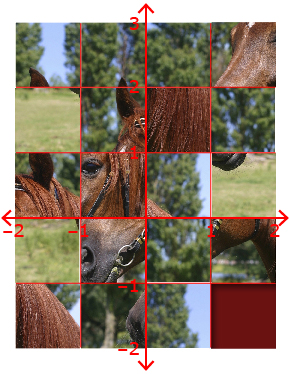Lesson 1
1. Lesson 1
Module 1: Function Transformations
Lesson 1: Horizontal and Vertical Translations

adapted from: iStockphoto/Thinkstock
Focus
A tile puzzle can be solved by sliding the tiles. In the puzzle shown, the goal is to rearrange the tiles to complete a picture of a horse. Imagine giving instructions to a friend who was playing the game. How would you describe what moves the friend should make? Suppose you put the tile puzzle onto a grid. Would you describe how a tile moves differently? Learning about transformations will give you a method to mathematically describe these movements.
Try your hand at Image Shuffle. After you launch the puzzle, you will need to right-click on the image and then select “Play.”
In this lesson you will learn how to translate the graph of a function of the form y − k = f(x − h). You will also learn how to determine the equation of the form y − k = f(x − h) from a graph.
Lesson Outcomes
At the end of this lesson you will be able to
- compare graphs of the form y − k = f(x − h) to the graph of y = f(x) and generalize a rule about h and k
- sketch a graph of a function of the form y − k = f(x − h) given the graph of y = f(x) and the values of h and k
Lesson Questions
You will investigate the following questions:
- How are the graphs of the functions y = f(x) and y − k = f(x − h) related?
- How can you graph the function y − k = f(x − h) given y = f(x)?
Assessment
Your assessment may be based on a combination of the following tasks:
- completion of the Lesson 1 Assignment (Download the Lesson 1 Assignment and save it in your course folder now.)
- course folder submissions from Try This and Share activities
- additions to Glossary Terms and Formula Sheet
- work under Project Connection
Self-Check activities are for your own use. You can compare your answers to suggested answers to see if you are on track. If you are having difficulty with concepts or calculations, contact your teacher.
Remember that these questions and activities provide you with the practice and feedback that you need to successfully complete this course. You should complete all the questions and place your responses in your course folder. Your teacher may wish to view your work to check on your progress and to see if you need help.
Materials and Equipment
- graph paper
Time
Each lesson in Mathematics 30-1 Learn EveryWare is designed to be completed in approximately two hours. You may find that you require more or less time to complete individual lessons. It is important that you progress at your own pace, based on your individual learning requirements.
This time estimation does not include time required to complete Going Beyond activities or the Module Project.
